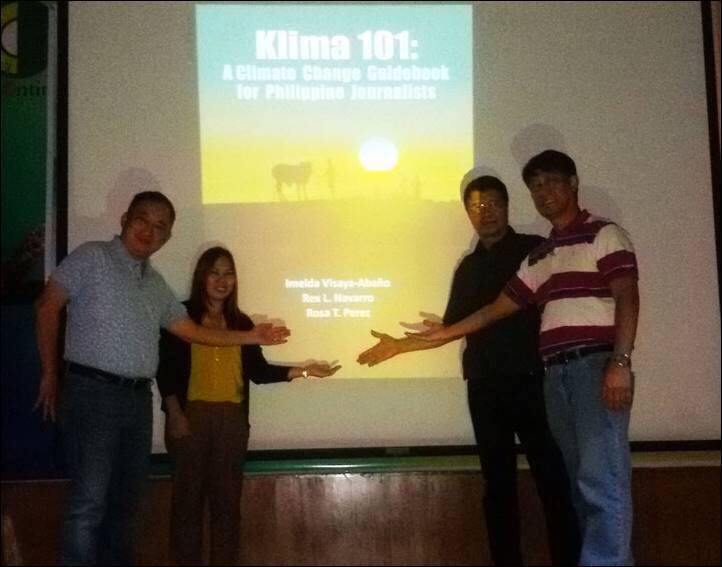The Klima 101: A Climate Change Guidebook for Philippine Journalists was released on September 17, 2016 coinciding with this year’s 40th Anniversary of the Philippine Agricultural Journalists (PAJ) during its general assembly at the Philippine Coconut Authority Auditorum.
Climate change is a complex issue and this guidebook aims to help journalists and editors, including journalism teachers and trainers, to navigate and understand scientific issues better. It hopes to provide a clear idea of the nature of climate change, what types of data and information journalists need to write or produce a story particularly on the impact of climate change on agriculture and food security, how to report climate issues effectively, and how to influence decision-making in the process, as well as generate public debate and action.
“ The quality and quantity of reports in the mainstream media need to improve. For journalists, therefore, climate change is both a challenge and an opportunity. It is a complex subject that impacts on almost everything we do. It is the context in which stories will unfold,” said Imelda Abano, President of the Philippine Network of Environmental Journalists (PNEJ).
Abano co-authored the guidebook with communications specialist Rex Navarro, a consultant of the CGIAR Research Program on Climate Change, Agriculture and Food Security for Southeast Asia (CCAFS SEA), and climate scientist Rosa Perez from the Manila Observatory.
The guidebook represents a joint effort among scientists, communicators and journalists facilitated by CGIAR Research Program on Climate Change Agriculture and Food Security in Southeast Asia (CCAFS SEA), with the Department of Agriculture, the Philippine Network of Environmental Journalists and the Philippine Agricultural Journalists.
Klima 101: A Climate Change Guidebook for Philippine Journalists is the product of a series of media workshops that brought the country’s experts and journalists to discuss media coverage and communication of climate change science conducted in the past two years.
Each chapter is designed to provide background information that can be useful in understanding challenges that journalists face in covering climate change.
Chapter 1 represents an overview of what scientists know about the climate system and how it works. It introduces basic concepts concerning the likely impacts and a range of possible solutions, the best scientific data available on the observed changes and impacts to the Philippines, as well as the challenge to the agriculture sector.
Chapter 2 discusses agriculture as the country’s backbone for sustainable attainment of food security. This chapter consists of the impacts of climate change on agriculture, crop production, livestock, fisheries, water resources and on food security. It introduces the concept of climate-smart agriculture and other agricultural practices to make communities resilient.
Chapter 3 provides brief background information on climate change plans and policies of the Philippine government.
Chapter 4 uses a straightforward language to help journalists deal with the complexities of climate change stories. It includes the larger issue of what journalists need to pursue after the Paris Agreement was adopted in December 2015 during the 21st Conference of Parties (COP21) of the United Nations Framework Convention on Climate Change (UNFCCC). Aside from the pitfalls and quick tips on reporting, this chapter also tackles the outcome of a three-year study on the challenges and opportunities faced by Filipino journalists in communicating climate change. It features a sampling of climate change stories written by local journalists.
Chapter 5 In this chapter, a quick note on agriculture and climate change reporting is included.
It also summarizes the discussion of a series of climate change media workshops held in the Philippines from 2015 to 2016, participated in by more than 500 journalists from Legazpi City, Tacloban City, Siargao Island and Tuguegarao City organized by the International Rice Research Institute (IRRI), CCAFS Southeast Asia, the Philippine Network of Environmental Journalists (PNEJ) and the Philippine Agricultural Journalists (PAJ).
Finally, the guidebook provides a glossary of technical terms that will help journalists in understanding and reporting climate change and communicating this to the average reader. Though not an exhaustive list, it provides details of non-media organizations, inter-governmental organizations, research centers working on climate change in the Philippines.
Latest posts by EnviroNewsph (see all)
- Global fund aimed at protecting nature and accelerate investment in conservation, launched in Canada - August 25, 2023
- Why ‘loss and damage’ is the most bitterly fought-over issue at COP27 climate talks? - November 18, 2022
- U.S. hands over P2.3M in equipment and wildALERT system to PH to protect wildlife - December 16, 2020

